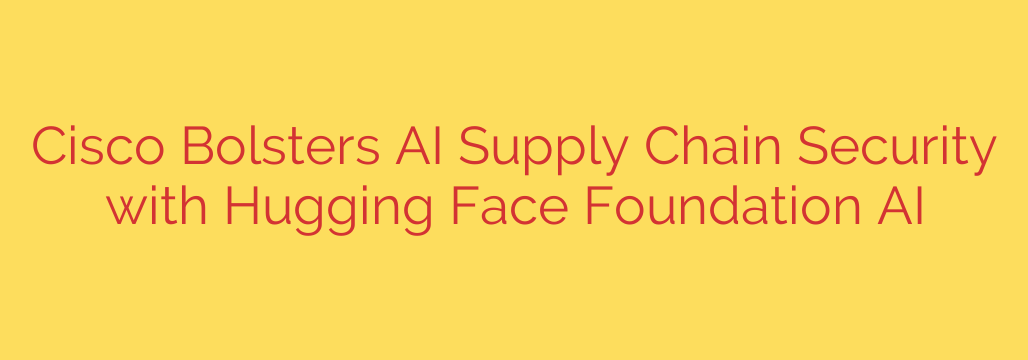
Securing the AI Revolution: Tackling Critical Risks in the AI Supply Chain
The rapid adoption of Artificial Intelligence is transforming industries, but this progress comes with a new and significant security challenge: the AI supply chain. As organizations increasingly rely on open-source AI models to power their innovations, they are also exposing themselves to a new landscape of cyber threats.
Just as the software world has grappled with vulnerabilities in open-source libraries, the AI community now faces the risk of malicious code hidden within pre-trained models. A compromised AI model, downloaded from a public repository, could act as a Trojan horse, leading to data theft, system manipulation, or the complete compromise of a corporate network.
Understanding and securing this AI supply chain is no longer an option—it’s a necessity for any organization serious about leveraging AI safely.
The Hidden Dangers in Open-Source AI Models
Platforms like Hugging Face have become invaluable hubs for the AI community, hosting millions of models that developers can use to accelerate their work. However, the very openness that drives this innovation also creates opportunities for malicious actors.
The primary risk lies in the model files themselves. Traditionally, many AI models were saved using formats like pickle, a Python-native format that can execute arbitrary code upon being loaded. This means a threat actor could embed malware directly into a model file. An unsuspecting developer who downloads and loads this model would inadvertently execute malicious code on their system, triggering a serious security breach.
The potential consequences are severe:
- Data Exfiltration: A compromised model could be designed to steal the sensitive data it processes.
- Backdoor Access: The model could create a persistent backdoor into your network for future attacks.
- Model Poisoning: The model’s behavior could be subtly altered to produce incorrect or biased results, sabotaging business processes.
A New Frontier in Security: Verifying AI Model Integrity
To combat these threats, a fundamental shift in how we handle AI models is underway. The industry is moving toward creating verifiable trust at every stage of the AI development lifecycle.
A landmark collaboration between cybersecurity leader Cisco and the open-source AI community Hugging Face is spearheading this effort. By integrating advanced security scanning capabilities directly into the AI development ecosystem, they are providing developers and organizations with the tools to verify the safety of AI models before they are ever deployed.
This initiative focuses on scanning models for hidden threats, ensuring that what you download is exactly what it claims to be—a clean, functional AI model, free from malicious payloads.
Why Safetensors are a Game-Changer for AI Security
A key component of this enhanced security is the adoption of a safer file format called Safetensors. Unlike the risky pickle format, Safetensors is designed specifically for storing the large data tensors that make up an AI model, and it does not allow for code execution.
By design, a Safetensors file contains only data. This simple but crucial distinction eliminates the risk of arbitrary code execution when a model is loaded. The move toward Safetensors as a community standard is one of the most significant steps toward securing the entire AI supply chain. When you use a model saved in the Safetensors format, you can be confident that you are not introducing an immediate code execution vulnerability into your environment.
Actionable Steps for Securing Your AI Pipeline
While industry collaborations are vital, organizations must also take proactive steps to protect themselves. Here are essential security tips for any team working with AI:
- Prioritize Safe Model Formats: Mandate the use of Safetensors over older, insecure formats like
pickle. Make this a standard part of your organization’s development policy. - Vet Your Sources: Don’t blindly download models from unknown or unverified publishers. Stick to reputable sources and models that have been scanned and validated by the community or security tools.
- Implement Automated Scanning: Integrate AI model scanning into your CI/CD pipeline. Use security tools that can inspect model files for malware, vulnerabilities, and other signs of tampering before they are approved for use.
- Maintain a Model Bill of Materials (MBOM): Just like a Software Bill of Materials (SBOM), an MBOM provides a complete inventory of all the AI models and their components used in your applications. This is critical for tracking dependencies and responding quickly if a vulnerability is discovered.
- Monitor Models in Production: Continuously monitor the behavior of deployed AI models for any anomalies. Unexpected outputs or performance could indicate that a model has been compromised.
The era of AI is here, and its potential is boundless. However, realizing this potential requires building on a foundation of trust and security. By understanding the risks in the AI supply chain and adopting new tools and best practices, we can ensure that the AI revolution is not only innovative but also safe.
Source: https://feedpress.me/link/23532/17111771/ciscos-foundation-ai-advances-ai-supply-chain-security-with-hugging-face








